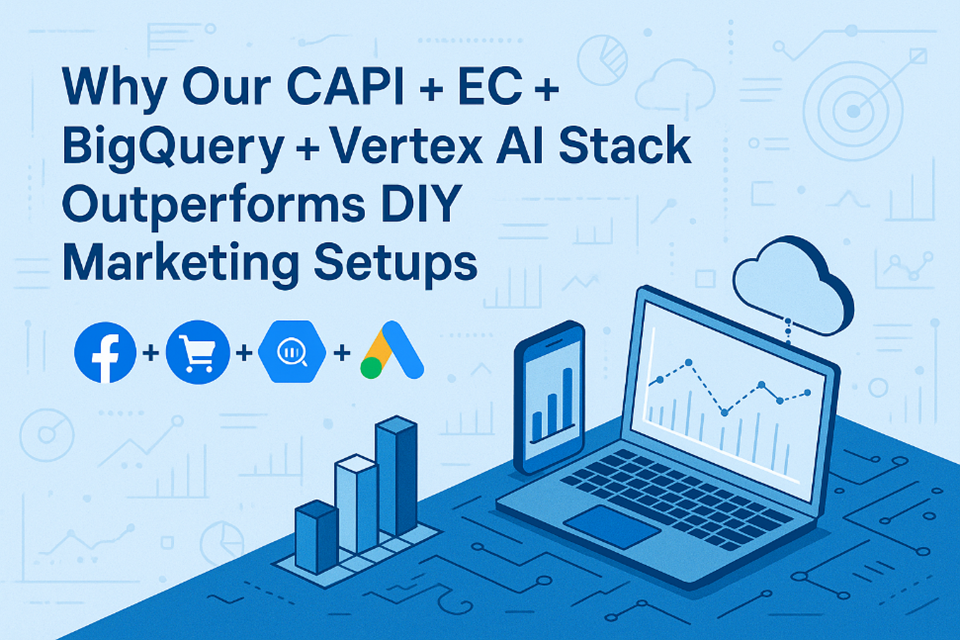 Loading Please Wait...
Loading Please Wait... Loading Please Wait...
Loading Please Wait...
In a rapidly changing marketing environment shaped by privacy regulations, platform limitations, and the diminishing effectiveness of third-party tracking, brands need more than just analytics. They need a connected infrastructure that doesn’t just report on performance but actively drives it.
At the core of our marketing intelligence platform lies a purpose-built stack: Conversion APIs (CAPI), e-commerce data connectors (EC), Google BigQuery, and Vertex AI. Together, these components form a resilient, scalable, and intelligent framework for modern marketers. Unlike DIY setups that rely on scattered scripts, spreadsheets, or custom connectors, our system delivers accuracy, continuity, and most importantly — activation.
Traditional marketing stacks rely on browser-side tracking, cookies, and third-party tags — all of which are becoming less reliable due to browser restrictions and privacy regulations like GDPR and CCPA.
Our approach starts with server-side data ingestion through Meta’s Conversion API and equivalent APIs from Google and other platforms, allowing us to capture high-quality, consented signals like page views, purchases, cart events, and more.
When paired with e-commerce platform integrations (such as Shopify, Magento, or custom-built platforms), we’re able to track transactional behavior with precision — down to variant-level SKU purchases, refunds, and inventory metadata. These aren’t just isolated events; they are normalized data points structured for downstream attribution and modeling.
After ingestion, consistency becomes the next big challenge. Many DIY systems fail because their marketing data lives in silos — exported from GA4, Ads Manager, or CRM platforms and combined manually.
Our ETL pipelines run daily, handle schema changes, and perform automated anomaly detection — so analysts and marketers don’t waste time debugging spreadsheets or fixing broken connectors.
Once the data is centralized, we activate it using Google’s Vertex AI to build and deploy machine learning models directly on top of BigQuery. These models go beyond surface-level insights to forecast future performance, recommend budget shifts, and segment high-value users in real time.
Because Vertex AI runs serverlessly within Google Cloud, we can schedule model retraining as new data flows in — ensuring predictions stay current and actionable.
What makes our stack unique is the seamless transition from intelligence to action.
We integrate model outputs directly with ad platforms and CRM systems, so that insights become interventions. High-value segments are synced with Meta and Google Ads. Budget recommendations are pushed into campaign plans. Underperforming campaigns trigger alerts or automated scaling decisions.
This closed-loop system ensures that marketers don’t just react to data — they act on it proactively, with confidence.
Our system is built with the future in mind. It’s cloud-native, privacy-compliant, and scalable for businesses of all sizes. Whether you’re managing millions of impressions or working across global regions, the architecture adapts without needing rework.
While many teams attempt to build similar capabilities internally, they often encounter blockers :
Over time, these gaps compound — leading to slower decision-making, inaccurate performance evaluation, and missed growth opportunities.
This stack isn’t just a tech solution — it’s a strategic foundation. It enables marketing teams to shift from reactive reporting to predictive decision-making. From isolated tools to integrated intelligence. From static dashboards to dynamic growth loops.
If you’re still relying on manual reports, stitched spreadsheets, or fragmented analytics, it might be time to rethink what “marketing infrastructure” truly means.
We offer tailored walkthroughs and live demos for organizations looking to transition from DIY to a full-stack approach. You’ll see exactly how data flows, how insights are generated, and how activation happens across platforms.
What would you love to learn how to do?